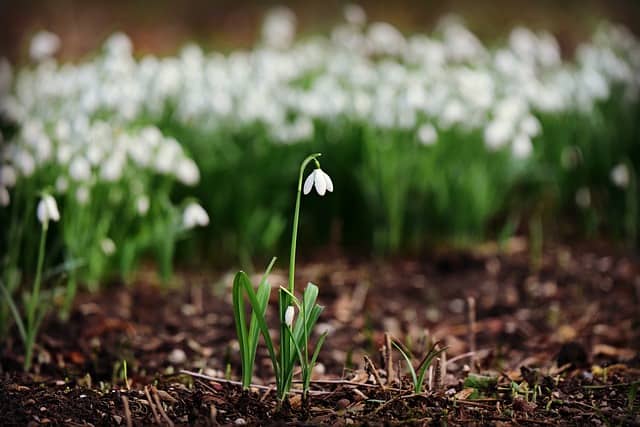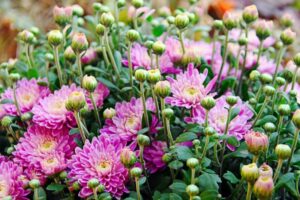In this in-depth guide, we will explore various bulbs that thrive when planted in winter, delve into their unique characteristics, and provide you with the essential information to help you create a stunning spring garden.
Allium

Allium, with its striking globe-shaped flower clusters, is a must-have for any garden. These bulbs, belonging to the onion family, come in a variety of heights, bloom times, and color shades, ranging from deep purples to soft whites. Allium bulbs should be planted in late fall to early winter, as they require a chilling period to produce their magnificent flowers in spring.
Planting Allium bulbs is straightforward. Choose a well-draining location with full sun, as these flowers thrive in bright light. Depending on the variety, you can plant them 4 to 6 inches apart, placing them 2 to 4 inches deep in the soil. Alliums resist pests, making them low-maintenance and a favorite amongst gardeners. They also attract pollinators like bees and butterflies, providing a vital source of sustenance in early spring.
As your Allium blooms begin to open in early to mid-spring, you’ll be rewarded with bold and whimsical flower heads that can reach up to 10 inches in diameter. Their sturdy stems stand tall against the wind, making them an excellent choice for borders or as cut flowers that brighten up any indoor space.
Crocus

Crocuses are the quintessential heralds of spring, often the first flowers to emerge from the melting snow. These hardy bulbs can be planted in late winter or even during milder spells, as they can withstand frost and cold conditions.
Crocus bulbs are small and easy to plant, requiring just a few inches of soil. They prefer well-draining soil and can thrive in full sun to partial shade. Plant them in clusters for a more impressive display, as they create a breathtaking carpet of colorful blooms spanning from shades of purple, yellow, and white.
Crocuses typically bloom in early spring, and their floral display can last for several weeks. They are also a favorite among pollinators and will attract bees that emerge early from their hibernation. Once they finish blooming, the foliage remains attractive, continuing to photosynthesize until early summer, contributing to the overall health of your garden.
Daffodil

Daffodils, known for their cheerful yellow flowers and trumpet-shaped blooms, are another fantastic bulb to plant in winter. They are tough, resilient plants that can tolerate a range of soil conditions as long as the soil is well-draining. Daffodils have the remarkable ability to naturalize, meaning they will return year after year and often multiply.
To plant daffodils, choose a location with full sun or partial shade and ensure that the soil is loose and rich in organic matter. Dig holes about 6 inches deep and plant the bulbs with the pointed end facing upwards, spacing them about 4 to 6 inches apart. This arrangement allows enough room for their foliage to spread as they grow.
Daffodils bloom in late winter to early spring, often providing the first truly vibrant splash of color in your garden. Their sweet, mild fragrance is a bonus, and they are resistant to deer and rodents, making them an ideal choice for gardeners with wildlife in the area. After blooming, allow the foliage to wither naturally as it stores energy for next year’s growth.
Hyacinth

For those who enjoy strong fragrances in their gardens, hyacinth bulbs are an exceptional choice. Known for their dense flower clusters and exquisite scent, hyacinths can add both beauty and fragrance to your winter-planted bulbs.
These bulbs prefer a sunny location and well-drained soil. When planting hyacinths, ensure you plant them 4 to 6 inches apart and 4 to 6 inches deep. You can choose to plant them in beds or pots, making them versatile for any gardening space. Hyacinths are also excellent for forcing indoors, allowing you to enjoy their beauty and fragrance even earlier than the outdoor blooms.
Hyacinths usually bloom from mid to late spring, producing vibrant flowers in an array of colors, including blue, pink, white, and purple. The blooms can last for several weeks if cared for properly. Additionally, hyacinth flowers are excellent for attracting honeybees and butterflies, enriching your garden’s ecosystem.
Iris

Iris bulbs, famed for their striking blooms and intricate petal structure, are winter-planted bulbs that can add visual interest to your garden. While there are many species of irises, the bearded iris is particularly popular due to its large flowers and range of colors, including blues, purples, yellows, and whites.
When planting bearded irises, it is essential to place them in well-drained soil with full sun exposure. Dig a hole and plant the bulbs so that the rhizome is just at soil level, allowing the roots to take hold while keeping the top exposed. Spacing them about 12 inches apart will ensure proper air circulation, reducing the chance of rot or disease.
Iris blooms usually grace gardens in late spring to early summer. Their tall, elegant stems can reach up to 3 feet, making them perfect for adding height to flower beds or borders. Once they’ve finished blooming, the foliage remains attractive through summer, providing added structure to the garden.
Snowdrop

One of the earliest bloomers, snowdrops, are delicate yet resilient bulbs that can thrive in winter conditions. These flowers are often one of the first signs that spring is on the way, pushing their way through the snow to present their elegant white blooms.
Snowdrops prefer a shady spot where they can receive dappled sunlight, ideally under deciduous trees that will provide cover in the summer months. Plant the bulbs about 3 inches deep and 3 to 4 inches apart in well-draining soil. Once they bloom, they create an enchanting display as they gently sway in the cold breeze.
The flowers typically emerge in late winter, sometimes even in January or early February, providing a gentle preview of the other spring flowers to come. Take care to allow their foliage to die back naturally after blooming, as this process is essential for future growth.
Tulip

Tulips are iconic spring flowers beloved for their bold colors and elegant shapes. Available in a wide range of colors and sizes, tulips can be planted in winter for early spring blooms. They perform exceptionally well in well-drained soil and full sunlight, making them ideal candidates for various garden settings.
When planting tulips, it is recommended to place the bulbs at a depth of about 6 to 8 inches, with the pointed end facing up. Maintain a spacing of about 4 to 6 inches between bulbs, as this allows them room to grow and display their beautiful blooms when spring arrives.
Tulips typically bloom in early to mid-spring, and their elegant flowers can last a few weeks, depending on the weather conditions. They are popular for cut flower arrangements and can bring a vibrant touch to any indoor space as well. After blooming, similar to other bulbs, allow the foliage to die back naturally to support next year’s growth cycle.
FAQs About Planting Bulbs
Q: When is the best time to plant bulbs in winter?
A: The ideal time to plant winter bulbs is in late fall to early winter, ideally before the ground freezes. This allows the bulbs to establish roots before they begin to grow in the spring.
Q: How deep should I plant my bulbs?
A: Generally, you should plant bulbs at a depth that is about 2 to 3 times their height. As a rule of thumb, small bulbs like crocuses should be planted around 3 inches deep, while larger bulbs like tulips and daffodils should be around 6 to 8 inches deep.
Q: Do winter-planted bulbs need special care?
A: Most bulbs are low-maintenance, but ensuring they have well-draining soil and appropriate sunlight is essential. After blooming, refrain from cutting the foliage until it has yellowed and died back, as this allows the bulbs to gather nutrients for the next season.
Q: Can I plant bulbs in pots for winter?
A: Yes! Planting bulbs in pots can provide flexibility in your garden design. Ensure the pots have adequate drainage holes, and use a quality potting mix. You can place the pots outdoors for winter dormancy.
Q: What if the weather gets too cold after planting?
A: Don’t worry! Most bulbs are hardy and can handle freezes. If significant freezing is expected, mulching over the bulbs with straw or leaves can provide extra insulation.
Bulbs You Can Plant by USDA Zone

Understanding your USDA hardiness zone is crucial in selecting the right bulbs to plant in winter. Here’s a brief summary of some suitable bulbs by zone:
Zone 3-4: Snowdrops, Crocus, Daffodils, and Hyacinths are great choices due to their hardiness against colder conditions.
Zone 5-6: In addition to the aforementioned bulbs, Alliums and Tulips thrive in these zones, offering winter resilience and a colorful spring display.
Zone 7-8: Fascinating varieties of Iris and Daffodils flourish here, as well as more tender Hyacinths and tulips.
Zone 9-10: Here, planting can extend to different species of Allium and excess options for Iris, given the milder winters.
Picking the right bulbs for your specific zone will ensure not only their survival through winter but also their vibrant comeback in spring.
Final Thoughts on Bulbs to Plant in Winter
While winter may often feel like a gardening lull, it is the perfect opportunity to prepare for vibrant spring displays. Planting bulbs during this season allows you to witness the transformative power of these resilient plants, as they break through the cold earth, signaling the return of sunshine and warmth.
Selecting a diverse range of bulbs, such as Alliums, Crocuses, Daffodils, Hyacinths, Irises, Snowdrops, and Tulips, can create a colorful tapestry that enchants your garden from the first hint of spring warmth until the season’s end. By planning ahead and caring for your bulbs responsibly, you can ensure a thriving and beautiful garden that showcases the magic of springtime.
Whether you are an experienced gardener or just starting, planting winter bulbs can become a cherished activity that connects you to the rhythms of nature and the joy of flourishing life. So as winter blankets your area this season, remember that the vibrant blooms of spring are lying in wait, ready to burst forth and herald a new beginning





